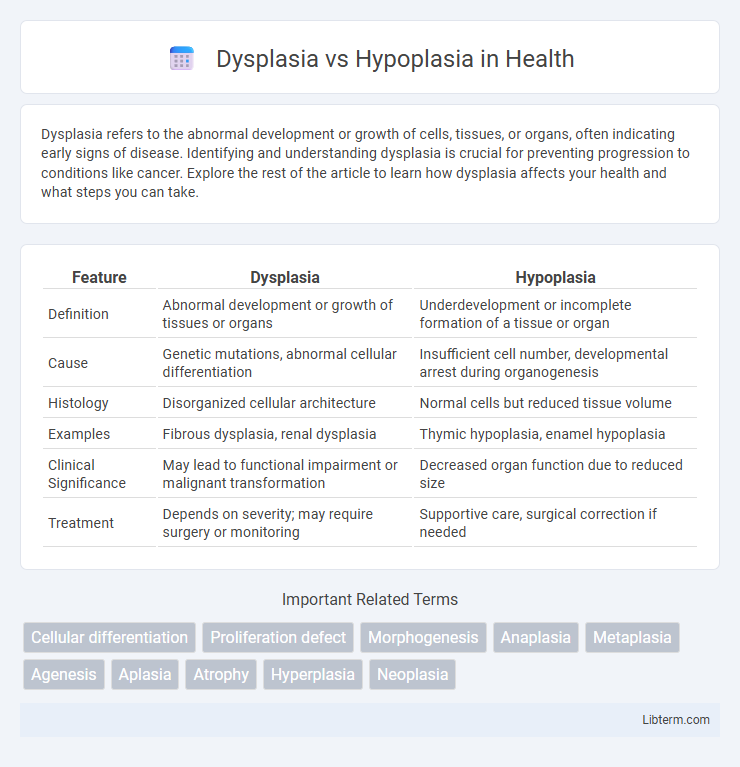Dysplasia refers to the abnormal development or growth of cells, tissues, or organs, often indicating early signs of disease. Identifying and understanding dysplasia is crucial for preventing progression to conditions like cancer. Explore the rest of the article to learn how dysplasia affects your health and what steps you can take.
Table of Comparison
| Feature | Dysplasia | Hypoplasia |
|---|---|---|
| Definition | Abnormal development or growth of tissues or organs | Underdevelopment or incomplete formation of a tissue or organ |
| Cause | Genetic mutations, abnormal cellular differentiation | Insufficient cell number, developmental arrest during organogenesis |
| Histology | Disorganized cellular architecture | Normal cells but reduced tissue volume |
| Examples | Fibrous dysplasia, renal dysplasia | Thymic hypoplasia, enamel hypoplasia |
| Clinical Significance | May lead to functional impairment or malignant transformation | Decreased organ function due to reduced size |
| Treatment | Depends on severity; may require surgery or monitoring | Supportive care, surgical correction if needed |
Understanding Dysplasia and Hypoplasia
Dysplasia refers to the abnormal development or growth of cells, tissues, or organs, often characterized by disorganized cell structure and impaired function. Hypoplasia, in contrast, is the underdevelopment or incomplete formation of a tissue or organ, resulting in a smaller size but typically with normal cellular organization. Understanding these conditions is essential for diagnosis and treatment, as dysplasia often indicates a potential for malignancy, whereas hypoplasia usually signifies congenital or developmental deficiencies.
Defining Dysplasia: Causes and Characteristics
Dysplasia refers to the abnormal development or growth of tissues or organs, characterized by disorganized cellular structure and atypical cell shapes. Common causes include genetic mutations, chronic inflammation, or exposure to carcinogens, which disrupt normal cell differentiation. This condition is often identified by irregular tissue architecture and abnormal cell proliferation, which can be precursors to malignancy.
Hypoplasia Explained: Causes and Features
Hypoplasia is characterized by the incomplete development or underdevelopment of a tissue or organ, resulting in a smaller size but with normal cellular organization. Causes of hypoplasia include genetic mutations, intrauterine infections such as rubella, nutritional deficiencies, and exposure to teratogens during critical periods of fetal development. Common features of hypoplasia involve reduced organ volume, functional impairment depending on the affected tissue, and often a lifelong impact on health requiring medical monitoring or intervention.
Key Differences Between Dysplasia and Hypoplasia
Dysplasia refers to the abnormal development or growth of cells, tissues, or organs, often characterized by disorganized cellular architecture and potential precancerous changes. Hypoplasia is the underdevelopment or incomplete development of a tissue or organ, resulting in a decreased number of cells but retaining normal cellular organization. The key difference lies in dysplasia involving structural abnormalities and abnormal cell differentiation, whereas hypoplasia denotes quantitative deficiency without altered tissue structure.
Clinical Manifestations of Dysplasia
Dysplasia presents clinically with abnormal cellular organization and atypical cell morphology, often resulting in tissue dysfunction and architectural distortion. Patients may exhibit symptoms related to organ-specific impairment, such as respiratory distress in pulmonary dysplasia or skeletal deformities in bone dysplasia. Early detection through imaging and histopathological examination is crucial for managing potential progression to malignancy or severe functional deficits.
Common Signs of Hypoplasia
Hypoplasia is characterized by the underdevelopment or incomplete development of a tissue or organ, commonly presenting with reduced size, diminished functionality, and structural abnormalities. Common signs of hypoplasia include smaller-than-normal organ size, decreased cellular density, and impaired growth evident in conditions like dental enamel hypoplasia or pulmonary hypoplasia. Unlike dysplasia, which involves abnormal cell growth and differentiation, hypoplasia primarily reflects quantitative deficiencies in tissue formation during development.
Diagnostic Approaches for Dysplasia and Hypoplasia
Diagnostic approaches for dysplasia primarily involve histopathological examination to assess cellular abnormalities and tissue organization, often utilizing biopsies and imaging techniques such as MRI or CT scans to detect structural anomalies. Hypoplasia diagnosis relies on clinical evaluation, radiographic imaging, and sometimes genetic testing to determine underdeveloped or incomplete organ or tissue growth. Advanced diagnostic tools, including ultrasound and molecular analysis, enhance accuracy in differentiating dysplasia from hypoplasia in clinical practice.
Treatment Strategies: Dysplasia vs Hypoplasia
Treatment strategies for dysplasia primarily involve surgical removal of abnormal tissue to prevent malignant transformation and may include adjunct therapies depending on severity. Hypoplasia treatment focuses on correcting underdeveloped tissues through regenerative techniques, physical therapy, or surgical reconstruction to restore function. Early diagnosis and tailored interventions significantly improve outcomes in both dysplasia and hypoplasia cases.
Prognosis and Outcomes: What to Expect
Dysplasia often leads to abnormal tissue or organ development with variable prognosis depending on severity and affected system, sometimes resulting in long-term functional impairments or increased risk of malignancy. Hypoplasia typically presents as underdeveloped but structurally normal tissue, usually resulting in reduced organ size and function, with outcomes largely dependent on the extent of underdevelopment and potential for compensatory growth. Prognosis in dysplasia tends to be more complex and uncertain compared to hypoplasia, which often allows for more predictable clinical management and outcome expectations.
Prevention and Early Detection
Preventing dysplasia and hypoplasia involves minimizing exposure to known risk factors such as infections, nutritional deficiencies, and genetic abnormalities through proper prenatal care and maternal health management. Early detection relies on advanced diagnostic tools like ultrasound imaging, biopsy, and molecular markers to identify abnormal tissue development or underdevelopment at initial stages. Timely intervention based on accurate diagnosis significantly improves prognosis and reduces complications associated with these developmental disorders.
Dysplasia Infographic

 libterm.com
libterm.com